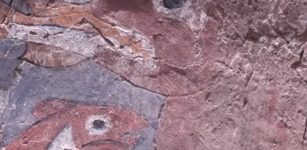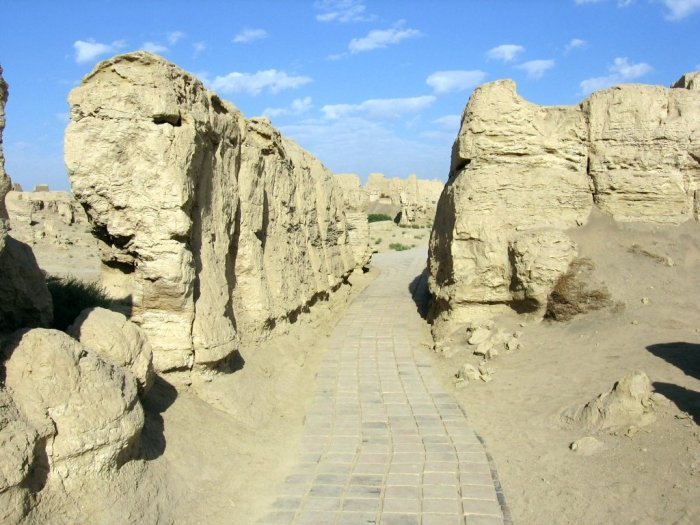Ruins Of 2,300-Year-Old City Of Jiaohe On The Silk Road
A. Sutherland - AncientPages.com - Jiaohe (in Chinese: 'where two rivers meet') is considered one of China's oldest, largest, and best-preserved earthen cities.
It was built 2,300 years ago, and its ruins are located along the Silk Road in the Yaernaizi Valley, 10 kilometers (6.2 miles) west of Turpan in Xinjiang Uygur Autonomous Region, China.
 Ruins of Jiaohe, a city where all the buildings were dug from earth and wood was rarely used. Credits: China Tour Guide
Ruins of Jiaohe, a city where all the buildings were dug from earth and wood was rarely used. Credits: China Tour Guide
As wood was rarely used, all its buildings were constructed from the earth. People dug houses and rooms downward from the ground and built them with dried bricks.
Jiaohe's main street was long and went down to the center of the islet (1650 m in length, 300 m wide), dividing the city into two parts. The western part was for ordinary people, and the rulers lived in the east. In the northwestern part of the city is a Buddhist monastery, and around China's oldest Buddhist stupa, there are 25 smaller stupas built in all directions.
 Buddhist stupa at Jiaohe Ruins. Photo: commons.Wikimedia
Buddhist stupa at Jiaohe Ruins. Photo: commons.Wikimedia
Jiaohe, which covered 220,000 square meters (2,368,168 square feet), was not like many other ancient cities.
First, it had only two city gates; the South Gate was the main one and vanished long ago, and the East Gate was cut from the side of the cliff, and a few remnants are still recognizable today.
No house gates faced the streets; military defense was seemingly the highest priority for this desert military town with a stronghold from 1,600 years ago.
Turfán (Turpan/Tulufán) es una ciudad-oasis en la Región Autónoma Uigur de Xinjiang en la República Popular China. Ruinas de la antigua ciudad de Jiaohe. Image credit: Colegota - CC BY-SA 2.5 ES
According to Tang dynasty records, Jiaohe had a population of 7,000. Second, typical city walls that usually surround other ancient cities were never found in the town; instead, Jiaohe faced cliffs on three sides.
Both excavations and historical records reveal evidence that Jiaohe (or 'Yarkhoto') was a flourishing ancient trading center and Jiaohe's military importance.
Sir Marc Aurel Stein (1862 - 1943) was a British archeologist and explorer of the Silk Road who traversed 25,000 miles of central Asia and western China. He suggested that the name 'Yarkhoto' is a combination of Turkic and Mongolian words.
The ancient city of Yar?ol near Turpan in the Xinjiang Uyghur Autonomous Region of the People’s Republic of China Image credit: Gregor Kneussel - CC BY-SA 3.0
With a history of more than 2,000 years, Jiaohe Ancient City stands isolated on a 30-meter-high plateau in the Ya'ernaizi Valley, 10 kilometers east of Turpan. The whole city of Jiaohe Ancient City stretches about 1650 meters from south to north and 300 meters from east to west.
The relics, still identifiable in this unique city, originated from Tang Dynasty (618-907) architectural style. According to Tang Dynasty historical records, Jiaohe was the capital of the Jushi Kingdom in 108 BC and remained until 450 AD.
Archaeological excavations revealed traces of the Jushi Kingdom at Jiaohe Valley, shedding more light on the early period of the region.
Later, Jiaohe continued to be an essential site for the Silk Road until it lost importance and was eventually destroyed by Genghis Khan.
Written by – A. Sutherland AncientPages.com Staff Writer
Updated on April 25, 2023
Copyright © AncientPages.com All rights reserved. This material may not be published, broadcast, rewritten or redistributed in whole or part without the express written permission of AncientPages.com
Expand for referencesMore From Ancient Pages
-
 1,300-Year-Old Mayan Maize God Sculpture Found in Palenque, Mexico
Archaeology | Jun 2, 2022
1,300-Year-Old Mayan Maize God Sculpture Found in Palenque, Mexico
Archaeology | Jun 2, 2022 -
 Soap Was Invented In 2800 B.C By Babylonians
Ancient History Facts | Jun 17, 2016
Soap Was Invented In 2800 B.C By Babylonians
Ancient History Facts | Jun 17, 2016 -
 Almost 1000 Previously Undiscovered Prehistoric Barrows Identified In The Netherlands
Archaeology | Oct 15, 2024
Almost 1000 Previously Undiscovered Prehistoric Barrows Identified In The Netherlands
Archaeology | Oct 15, 2024 -
 Hybrid Camels Revealed In Ancient Arab Temple Art At Hatra, Northern Iraq
Archaeology | Mar 15, 2022
Hybrid Camels Revealed In Ancient Arab Temple Art At Hatra, Northern Iraq
Archaeology | Mar 15, 2022 -
 Madagascar Hippos Were Forest Dwellers – New Study
Fossils | Jul 8, 2023
Madagascar Hippos Were Forest Dwellers – New Study
Fossils | Jul 8, 2023 -
 On This Day In History: Reginald Walter Bonham Was Born – On Jan 31, 1906
News | Jan 31, 2017
On This Day In History: Reginald Walter Bonham Was Born – On Jan 31, 1906
News | Jan 31, 2017 -
 Modern Humans Inherited DNA From A Mysterious And Unidentified Ancestor
DNA | Aug 7, 2020
Modern Humans Inherited DNA From A Mysterious And Unidentified Ancestor
DNA | Aug 7, 2020 -
 1,700-Year-Old Moche Culture Ceremonial Banquet Hall Discovered In Peru
Archaeology | Jan 12, 2018
1,700-Year-Old Moche Culture Ceremonial Banquet Hall Discovered In Peru
Archaeology | Jan 12, 2018 -
 On This Day In History: England’s Act Against Multipliers Signed Into Law – On Jan 13, 1404
News | Jan 13, 2017
On This Day In History: England’s Act Against Multipliers Signed Into Law – On Jan 13, 1404
News | Jan 13, 2017 -
 Is Mysterious Herlaugshaugen The Ship Burial Of Viking King Herlaug?
Archaeology | Jul 11, 2023
Is Mysterious Herlaugshaugen The Ship Burial Of Viking King Herlaug?
Archaeology | Jul 11, 2023 -
 Early Humans Were Probably Driven To Extinction By Climate Change- Study Suggests
Civilizations | Oct 15, 2020
Early Humans Were Probably Driven To Extinction By Climate Change- Study Suggests
Civilizations | Oct 15, 2020 -
 The Chinese Nostradamus And His Striking Predictions
Featured Stories | Sep 15, 2018
The Chinese Nostradamus And His Striking Predictions
Featured Stories | Sep 15, 2018 -
 Ashvins: Vedic Twin Gods Of Medicine And Healing Were Skilled Surgeons
Featured Stories | Feb 1, 2019
Ashvins: Vedic Twin Gods Of Medicine And Healing Were Skilled Surgeons
Featured Stories | Feb 1, 2019 -
 Origin Of The Genetic Code – Study
DNA | Dec 16, 2024
Origin Of The Genetic Code – Study
DNA | Dec 16, 2024 -
 Sacred Crystals Of The Cherokee – Myths, Traditions And History Explained
Featured Stories | Jun 3, 2019
Sacred Crystals Of The Cherokee – Myths, Traditions And History Explained
Featured Stories | Jun 3, 2019 -
 Archaeological Evidence Amazon Warrior Women Did Exist Found At Nakhchivan Necropolis, Azerbaijan
Archaeology | Mar 27, 2024
Archaeological Evidence Amazon Warrior Women Did Exist Found At Nakhchivan Necropolis, Azerbaijan
Archaeology | Mar 27, 2024 -
 Re-Writing History Of England’s Domesday Book Of William I The Conqueror
Archaeology | Nov 27, 2018
Re-Writing History Of England’s Domesday Book Of William I The Conqueror
Archaeology | Nov 27, 2018 -
 Tooth Enamel Reveals Life Histories Of Early Humans
Archaeology | Jan 16, 2023
Tooth Enamel Reveals Life Histories Of Early Humans
Archaeology | Jan 16, 2023 -
 Trolls – Fascinating Mythical Creatures Of Scandinavia
Featured Stories | Jun 13, 2022
Trolls – Fascinating Mythical Creatures Of Scandinavia
Featured Stories | Jun 13, 2022 -
 Archaeologists Discover Gloucestershire’s Hidden Treasures
Archaeology | May 14, 2024
Archaeologists Discover Gloucestershire’s Hidden Treasures
Archaeology | May 14, 2024


